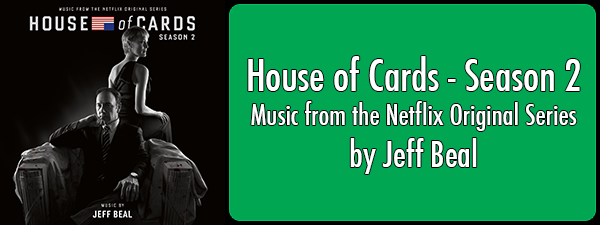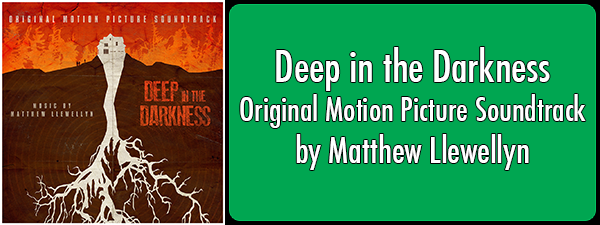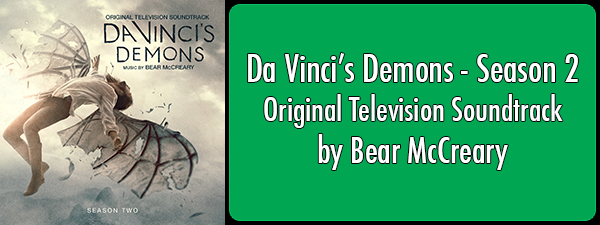In the fourth installment of CHUD’s soundtrack review column, we’ve got scheming politicians, young up-and-comers, and highly improbable flying machines. Which soundtracks should you be adding to your collection? Read on to find out!

Who composed it?: Jeff Beal
Who released it?: Varese Records
Who’s it for?: People who want an underscore for their scheming.
What’s the Lowdown?: When I’m not listening to soundtracks, I’m an avid podcast listener. One of the most fascinating podcasts about music is Song Exploder, in which songs are picked apart piece by piece. Episode seven of the podcast features a Jeff Beal-hosted breakdown of his Emmy nominated Main Title Theme, in which he reveals some subtle changes that took place for the season two version.
Subtle changes and variations are what this season’s soundtrack really has to offer. The first season established a strong precedent for how the show would look and sound, and if you’ve watched the second season you’d know that not much has changed in that department. It still looks and sounds as good as ever, but that means you’re in for more of the same. A lot more. This double-disc soundtrack album features nearly two hours of music, and much of it features the signature bass throb, crisp harp melodies, and icy, reverb-drenched piano that define the show’s musical identity.
Beal’s string arrangements, while never as spirited as in the Main Title Theme, still show signs of vibrant life in tracks like Two Minutes, which features some fun pizzicato arpeggios in the cellos and basses. Despite being a (really great) trumpet player, Beal holds back on the brass throughout the score. His trumpet solos make rare appearances on the album, but they’re always welcome, especially in the noir-tinged Distance Myself or the Herrman-esque Toxic President. Also used sparingly is the operatic wail of a female soloist, which adds to the show’s inherently operatic feel.
Jeff Beal’s score for the second season of Netflix’s House of Cards may not represent a marked evolution of the show’s music, but then again, the second season itself was not a marked evolution of the first. Nevertheless, Beal’s score is still a remarkably well executed and fitting musical backdrop for the frigid, sinewy intrigue of Francis Underwood’s DC. Buy it here.
Standout Tracks:
- Main Title Theme
- Toxic President
- To Be King
- Distance Myself

Who composed it?: Matthew Llewellyn
Who released it?: Screamworks Records
Who’s it for?: Those of you who want fresh blood.
What’s the Lowdown?: Chiller’s adaptation of Michael Laimo’s 2004 Bram Stoker Award-Nominated novel seemed promising based on premise alone: the synopsis reads like Jack Ketchum meets The Descent by way of Don’t be Afraid of the Dark. Unfortunately, I hear the adaptation didn’t turn out so well, which isn’t surprising if you’ve seen the trailer. There was the possibility of a silver lining, though: I had heard the music was good.
Composer Matthew Llewellyn is an associate of Brian Tyler, having worked with him on Iron Man 3, Assassin’s Creed IV, Thor: The Dark World, and more. Though he may work with Tyler frequently, Llewellyn’s work on Deep in the Darkness shows that his style is decidedly less contemporary, evoking shades of Elmer Bernstein, Bernard Herrman, Chris Young’s The Fly II, and Scissorhands/Batman-era Danny Elfman.
The score for Deep in the Darkness is unexpectedly HUGE, performed by the Slovakia National Symphony Orchestra in a near flawless recording. The size of the orchestra and the decidedly sweeping nature of the cues lend a gloss and value that seems suited for a much bigger (and frankly better) film. His composition here is all strings, brass, and percussion. He doesn’t let the woodwinds take the melody at all, which makes sense given that the tone of the film doesn’t seem suited to clarinet solos. The soundtrack is also (seemingly) devoid of electronic instruments, which is goddamn refreshing.
Llewellyn’s approach to the material is very thematic, introducing several big themes in the first four tracks of the album. The opening track kicks off with immediate dread and horror, using big timpani rolls and shrieking violins to great effect. The next few tracks are where we get the Elfman-eqsue stuff, as we are introduced to the central characters and their new home in Ashborough. Llewellyn’s classic approach to the themes works very well most of the time, but his sentimental family theme is a bit saccharine for my taste, creating a tonal dissonance that feels a bit out of place in an R-rated movie about a clan of subterranean monsters. The most egregious instance of this over-sweetened theme comes at the beginning of Don’t Trust Lady Zellis, but I can’t complain about it on a composition level. It’s well composed, just like the rest of the album.
Deep in the Darkness is Matthew Llewellyn’s third feature for Chiller, but based upon the reception to this album, I wouldn’t be surprised if he were tackling larger projects in the near future. He’s young, talented, and if he can stick to the right projects I think he’s got a hell of a future ahead of him. Buy the soundtrack here!
Standout Tracks:
- Deep In The Darkness
- The Deighton Residence
- You Can Protect Me
- Back Into the Light

Who composed it?: Bear McCreary
Who released it?: Sparks & Shadows
Who’s it for?: Ornithopter enthusiasts.
What’s the Lowdown?: Before I get into the review proper, I would just like to congratulate Bear McCreary on his newest big accomplishment: fatherhood. He and his wife Raya Yarbrough have just welcomed their first child into the world, so if you guys are feeling magnanimous, go send him some congratulatory tweets @bearmccreary.
Now that I’ve gotten that out of the way, let’s talk about Da Vinci’s Demons. I’ve not seen a single episode, but I know this: the show’s about a young Leonardo Da Vinci, it was created by David Goyer, and it’s got a fucking great name. I also know that Bear McCreary won an Emmy for his Main Title Theme. What I didn’t know was that the main title theme is deceptively clever: it’s a musical palindrome. Play it backwards, and it sounds exactly the same as it does normally. But that’s not why it won the Emmy. It won that Emmy because it’s a great theme, regardless of anything one might consider “gimmicky” about it.
While this season two soundtrack doesn’t actually feature the Main Title Theme as a standalone track, the melody is used frequently throughout the score as Da Vinci’s signature theme. In addition to several themes from the first season, McCreary has introduced some new motifs, textures, and instruments to the score. Season two featured the young Da Vinci arriving at Machu Picchu (don’t ask me, ask David Goyer), so McCreary made the obvious (and difficult) choice of using traditional native Andean singers to chant real pre-Colombian melodies and lyrics. You’ll hear them featured prominently in the appropriately titled track Machu Picchu and the next track, The Test of Worthiness. As you might expect, the Andean vocals lend a surprising authenticity. Also heard are traditional wood flutes and tribal percussion, which broaden the show’s already wide palette of traditional renaissance-era instruments like the viola da gamba (featured prominently in the main title) and violone.
Something that has become a bit of a sore point for film score aficionados these days is the frequent use of ostinato, a short, repeating musical pattern that repeats constantly throughout a song (or part of a song). McCreary is a frequent employer of ostinato, especially in his string parts, and a great example of this would be the repeating arpeggiated melody in McCreary’s theme for The Walking Dead. The theme for Da Vinci’s Demons also features ostinato, but unlike The Walking Dead, the ostinato is under the melody. Some critics say that use of ostinato among film/tv/game composers has become somewhat of a meme or fad, and that it hides lazy composing. While this might be true of some composers, I don’t think McCreary is using ostinato to cover up any laziness. His score for the second season of Da Vinci’s Demons is another strong body of work, albeit not as unique or exciting as his work on Black Sails.
If I had any further grievance with the score (aside from some out-of-tune singing on the first track) it would be that it sounds a bit like Jesper Kyd’s work on Assassin’s Creed II and Assassin’s Creed Brotherhood, games that utilize some of the same locations, ideas, and even characters as Da Vinci’s Demons. Assassin’s Creed came first, though. Don’t get me wrong, I can tell McCreary’s work apart from Jesper Kyd’s any day, which isn’t to say that either is a bad composer. I like them both, and I’m certainly not accusing McCreary of borrowing any ideas from Kyd. All I’m saying is that one can easily spot parallels between the show and the game, but you may want to talk to David Goyer about that. Buy the soundtrack here!
Standout Tracks:
- Transfusion
- The Test of Worthiness
- The Voice in the Vault
- The Brazen Head